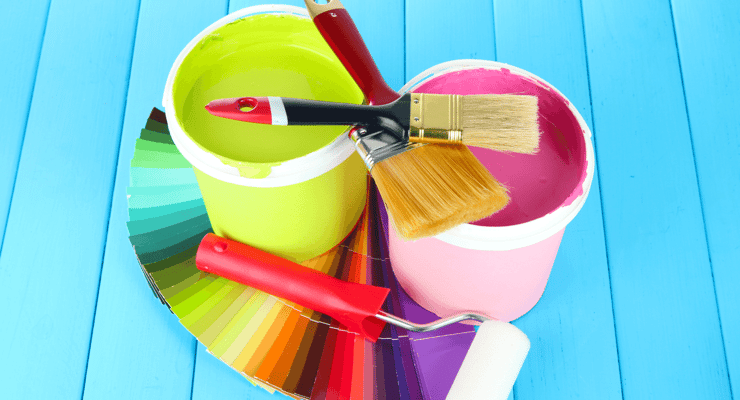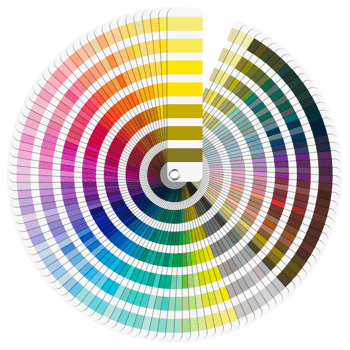 Whether you're planning on doing a complete remodel of your home or simply want to add a dash of colour to a room, it's important to understand how colours can complement each other. When viewed in the sky, a rainbow displays the natural progression of visible colours from red on one end to violet on the other, but professional designers rely on a colour wheel to properly understand and pair colours.
Whether you're planning on doing a complete remodel of your home or simply want to add a dash of colour to a room, it's important to understand how colours can complement each other. When viewed in the sky, a rainbow displays the natural progression of visible colours from red on one end to violet on the other, but professional designers rely on a colour wheel to properly understand and pair colours.
While there are definitely many benefits of using an interior designer, the good news is that you don't need to be a professional to understand the fundamentals of complimentary colours and choose a lovely decor for your home.
Understanding the Basics of Colour
Regardless of what you may have learned, the human eye sees only three primary colours: red, blue, and yellow. These three colours can be combined to produce the secondary colours: orange (red plus yellow), green (blue plus yellow), and purple (red plus blue). All other colours are referred to as tertiary colours, produced by mixing one of the above in different strengths.
The simple trick to remembering how to choose paint pairings for your home is to balance the colours. Red and purple rarely look good together because they are too similar, while very contrasting colours like red and blue are usually too intense. The trick to creating pleasant paint pairings is to give the colours equal weight or to choose a complimentary secondary or tertiary colour as an accent to a primary colour.
 1. Red and Green
1. Red and Green
Many home decorators stumble when it comes to understanding how to balance colours with wood furniture or items. Dark wood (or wood with a dark stain) has a red undertone when it's perceived by the eye, and so green is a great choice for a complimentary colour.
If you've got dark wood cabinets or want to decorate a room with a lot of dark-coloured wood, consider using green as your complimentary colour. Dark green can keep living rooms elegant while lighter, more fun shades of green can do wonders to liven up kitchens.
2. Orange and Blue
Certainly, choosing to add bold orange and blue hues would probably be too much for most rooms. But if you consider that a lot of wooden furniture has an orange hue to it, this can be a great way to frame the rest of the room with blue walls or blue accents. Darker blues for the walls are often a popular choice while lighter hues of blue can do wonders for drawing the eye towards prized wood furniture items like a heritage sideboard or dresser.
3. Red-Orange and Blue-Green
Instead of going all out with solid primary pairings, you can often work subtle magic by choosing less bold mixtures of hues. Pops of red-orange accessories in a room work well as accents against cool blue-green shades on the walls.
4. Yellow-Orange and Blue-Violet
Yellow is a very strong and energetic colour, as is its cousin orange, so use these hues sparingly. But there are times when you want to add life and vibrancy to a room. Using warm yellow-orange hues for walls can match perfectly with refreshing blue-violet colours in livelier areas of the house such as a bathroom or bedroom.
5. Yellow-Green and Red-Violet
This colour pairing may seem unusual at first thought, but they actually appear together in the most natural setting. If you've ever seen a field of red-violet flowers against yellow-green foliage, then you know what we're talking about. Although yellow-green colours can be a little overwhelming for some rooms, these can add a lot of life to a kitchen, sunroom, or patio. Add a lighter hue of red-violet to pair with brighter yellow-green and you'll create a very warm and cozy atmosphere.
 6. Yellow and Violet
6. Yellow and Violet
Going all out with solid yellow and purple is a bit too much for any space (perhaps save for a play room.) But you can really get a lot of mileage with a more subtle interplay of these two colours. Consider using both yellow and violet as accents such as in throw pillows, window casing, drapes, chairs, or area rugs in an otherwise drab room. Hints of these two colours add a lovely burst of energy without overwhelming the eye.
It's easy to find colour wheels online that allow you to choose a primary colour for your home redecoration and then easily pair it with a complementary paint colour. Remember that solid hues will look more intense when used in large amounts (such as for walls) than they do on the sample paint strip at the store.
Whether you start with a blank slate or want to add vibrancy to existing furniture and interior decor, the correct pairing of colours will result in a very pleasing aesthetic. It's okay to go for bolder colours for smaller areas and accent items, but choose less intense hues for larger spaces. Once you understand the fundamentals of colour matching, you'll be inspired to transform your house into a home.

 1. Red and Green
1. Red and Green 6. Yellow and Violet
6. Yellow and Violet



